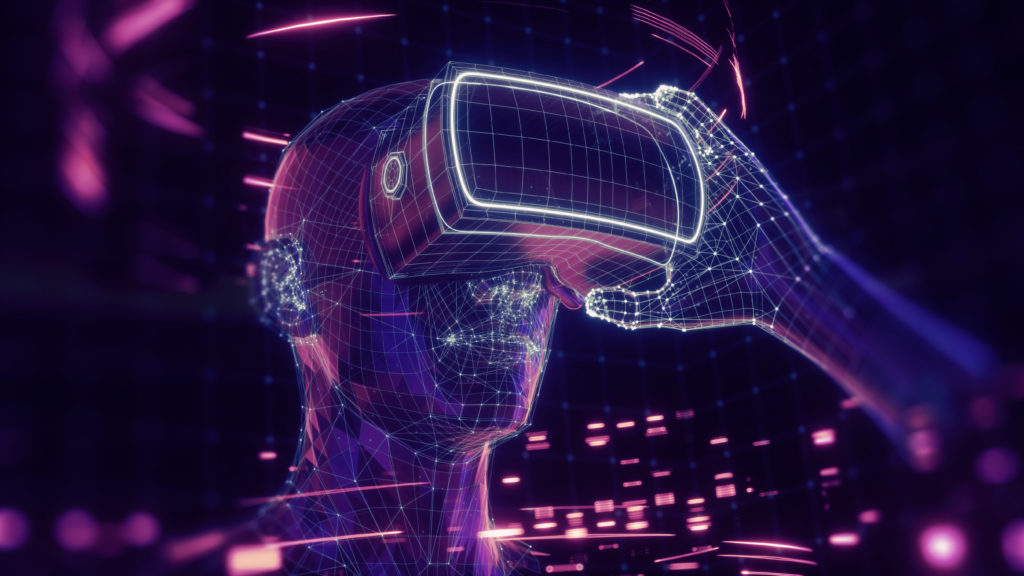“As we look to a world that could be shared among physical and virtual environments, brand owners should consider protecting virtual goods and services as well as those in the physical world.”
 The metaverse is commonly known as “a collective virtual shared space, created by the convergence of virtually enhanced physical reality and physically persistent virtual space, including the sum of all virtual worlds, augmented reality, and the Internet.” The metaverse may eventually provide a three-dimensional or virtual world for users to shop, play games, travel, learn, socialize, work, compete, or otherwise experience life in a virtual environment. Users may eventually visit the metaverse for an activity or even choose to live much of their life in this virtual world.
The metaverse is commonly known as “a collective virtual shared space, created by the convergence of virtually enhanced physical reality and physically persistent virtual space, including the sum of all virtual worlds, augmented reality, and the Internet.” The metaverse may eventually provide a three-dimensional or virtual world for users to shop, play games, travel, learn, socialize, work, compete, or otherwise experience life in a virtual environment. Users may eventually visit the metaverse for an activity or even choose to live much of their life in this virtual world.
A user’s experience within the metaverse will mimic the physical world, though not every object in the metaverse represents an object in the physical world. A virtual shopping experience in the metaverse may resemble a real-world version of a shopping mall, perhaps personalized to the user. A virtual workspace, such as an office or conference room, may facilitate remote work and continue to enhance virtual meetings. Gaming is expected to continue to evolve by becoming more realistic and more adaptive in real-time.
A user’s appearance in these environments, whether in a game, at work, or other social interaction could be portrayed as a digital avatar that represents the user in a realistic or even a fantasy-like appearance. There are limitless opportunities to configure a user’s appearance and capabilities, including what an avatar wears, how it speaks, whether it can fly, where it resides in a virtual environment, how it makes or spends money, and more.
The digital world may be approaching realism, but it is still an extension of the physical world. Intellectual property issues in the real world will also extend to the metaverse, though there are also opportunities that present themselves in the metaverse.
Non-fungible tokens (NFTs) are an enhancement to blockchain technology and offer functionality to track and limit the use of proprietary rights. NFTs are minted on the blockchain and may provide a more immutable solution for recording unique ownership rights, establishing authenticity, and distributing rights. In implementation, a brand, music, or other media linked to an NFT may only be displayed upon confirming ownership of that NFT. A minter may configure that NFT to offer such functionality to use certain media without actually conveying ownership of the underlying intellectual property rights. An infrastructure utilizing NFTs may offer new capabilities for ensuring proper use of intellectual property rights.
Web3 (or Web 3.0) is an emerging iteration of the Internet in which the tech industry is trying to merge the benefits of the metaverse and NFT/blockchain technologies. Where Web 1.0 refers to a time of static webpages and centralized data servers, Web 2.0 offers decentralized data (e.g., cloud hosting) and content-generation (e.g., social media, blogs, wikis). Web 2.0 still centers on large tech companies hosting the Web 2.0 services. Web3 furthers decentrialization by moving data from hosted clouds to decentralized blockchains and other decentralized storage locations. Users’ online experiences are likely to evolve to remove the need for storefront websites or web-applications to access data, because the decentralized storage removes the tight links between the host service and the data. Rather, data can be accessed through a variety of applications, such as the metaverse. In a simplified metaverse shopping mall example, the user’s metaverse software could access the decentralized data, such as NFTs, representing the user’s avatar, the stores in the mall, the products available in each store, and the user’s wallet.
1. Protecting Brands
Brand owners will want to engage with new and existing customers in the metaverse. The brand owners will want to protect the brand with trademark protection and police the use of the brand as it is used in the virtual world. As we look to a world that could be shared among physical and virtual environments, brand owners should consider protecting virtual goods and services as well as those in the physical world. Brand owners will want to protect the use of their mark and their products from being used on avatars (such as a logo appearing on a shirt of an avatar) or used as an object in a virtual world (such as a particular car appearing in a video game).
There are two cases currently addressing the issue of trademark protection for virtual products represented by NFTs. The first is the MetaBirkins case, in which Hermes sued for trademark infringement against an individual who was minting NFTs containing virtual representations of Hermes Birkin bags. In a similar case, Nike sued StockX for selling NFTs representing Nike shoes. There is more to follow on these two cases, but thus far, courts have respected conventional notions of trademark protection to NFTs and the metaverse. Nevertheless, brands are filing trademark applications for metaverse or NFT representations of their real world goods or services.
2. Protecting Inventions
Innovators have been devoting significant efforts to building the metaverse, which includes new functionality and builds on previous virtual reality and augmented reality foundations. Innovations include new methods for purchasing physical or virtual products, cryptocurrencies for use across the metaverse, tying physical and virtual items to connect the physical and virtual worlds, as well as others related to infrastructure involving artificial intelligence, blockchain, communication protocols, and cloud computing. Various aspects may be patentable and such protection should be pursued quickly as the rate of innovation has quickly ramped up for metaverse technologies.
3. Copyright Protection
Copyright owners will want to monitor the metaverse for their copyrighted expressions. As any physical item may be represented in the virtual world, there is a possibility that various works of art, such as paintings or sculptures, could appear in a virtual environment in the metaverse. A virtual environment may also present scenes from movies or play songs, perhaps even display a character from a book or a movie as an interactive individual. Some copyrights are used to protect digital items, such as digital artwork, which may be even easier to display in a virtual environment. Software may also be susceptible to theft in the metaverse as it may be appropriated to provide functionality in the metaverse. As a result, whether creating a new expression for the metaverse or protecting those intended for the physical world, copyright holders have a new frontier to monitor.
4. Jurisdiction and Enforcement
The multi-jurisdictional nature of the Internet presents challenges to determining where to enforce intellectual property rights that are specific to a particular domain. An entity may also interact in the metaverse with more anonymity than in the physical world, raising the difficulty in identifying infringers. Though the metaverse may add to the complexity of these problem through an even more integrated virtual world, the enforcement solutions may be similar to other Internet-based approaches.
Image Source: Deposit Photos
Author: wacomka
Image ID: 236672872

![[IPWatchdog Logo]](https://ipwatchdog.com/wp-content/themes/IPWatchdog%20-%202023/assets/images/temp/logo-small@2x.png)


![[Advertisement]](https://ipwatchdog.com/wp-content/uploads/2024/04/Patent-Litigation-Masters-2024-sidebar-early-bird-ends-Apr-21-last-chance-700x500-1.jpg)

![[Advertisement]](https://ipwatchdog.com/wp-content/uploads/2021/12/WEBINAR-336-x-280-px.png)
![[Advertisement]](https://ipwatchdog.com/wp-content/uploads/2021/12/2021-Patent-Practice-on-Demand-recorded-Feb-2021-336-x-280.jpg)
![[Advertisement]](https://ipwatchdog.com/wp-content/uploads/2021/12/Ad-4-The-Invent-Patent-System™.png)







Join the Discussion
No comments yet.